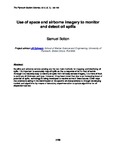Use of space and airborne imagery to monitor and detect oil spills
| dc.contributor.author | Bolton, S. | |
| dc.date.accessioned | 2019-05-17T09:07:47Z | |
| dc.date.available | 2019-05-17T09:07:47Z | |
| dc.date.issued | 2015 | |
| dc.identifier.citation |
Bolton, S. (2015) 'Use of space and airborne imagery to monitor and detect oil spills', The Plymouth Student Scientist, 8(1), p. 158-166. | en_US |
| dc.identifier.issn | 1754-2383 | |
| dc.identifier.uri | http://hdl.handle.net/10026.1/14089 | |
| dc.description.abstract |
Satellite and airborne remote sensing are the two main methods for mapping and identifying oil spills. It is important to accurately map oil spills so that a response effort is most effective. Although it is relatively easy to identify oil spills from remotely sensed imagery, it is more difficult to estimate oil thickness and type. However, it has been noted that due to an increasing issue of potential oil spills, technology is being developed to resolve some of these issues. Other ways that science is aiding in the identification of the specific oil characteristics is through developing models and algorithms by means of laboratory experimentation to update algorithms for oil dispersion rate etc. | en_US |
| dc.language.iso | en | en_US |
| dc.publisher | University of Plymouth | |
| dc.rights | Attribution 3.0 United States | * |
| dc.rights.uri | http://creativecommons.org/licenses/by/3.0/us/ | * |
| dc.subject | satellite remote sensing | en_US |
| dc.subject | airborne remote sensing | en_US |
| dc.subject | mapping and identifying oil spills | en_US |
| dc.subject | oil | en_US |
| dc.subject | oil spills | en_US |
| dc.subject | mapping | en_US |
| dc.title | Use of space and airborne imagery to monitor and detect oil spills | en_US |
| dc.type | Article | |
| plymouth.issue | 1 | |
| plymouth.volume | 8 | |
| plymouth.journal | The Plymouth Student Scientist |



